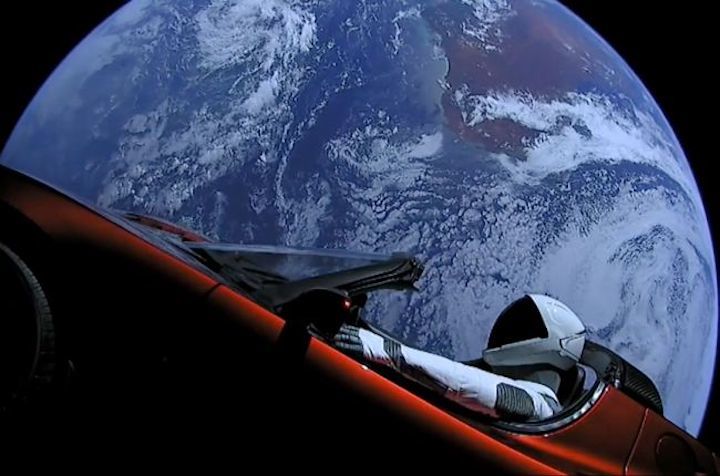21.08.2019
The deep-space duo have come full circle.

SpaceX's Starman mannequin sits inside Elon Musk's red Tesla Roadster with Earth in the background, shortly after the initial launch of SpaceX’s Falcon Heavy rocket on Feb. 6, 2018.
Starman and his deep-space ride have completed their first lap around the sun.
The spacesuit-clad mannequin, who sits behind the wheel of SpaceX founder and CEO Elon Musk's red Tesla Roadster, launched on Feb. 6, 2018, on the inaugural flight of the huge Falcon Heavy rocket.
The duo wrapped up their first solar orbit over the weekend, according to the tracking site whereisroadster.com. Starman and the Tesla have an orbital period of about 557 Earth days, the website calculated, and they've been in space for 560 days as of Monday (Aug. 19).
At launch, the Roadster's radio was playing David Bowie's "Life on Mars." If the car's battery is still working, Starman has now heard the song more than 150,000 times, according to the tracking site. And the site provides some other interesting tidbits as well. For example, the Tesla has now traveled more than 760 million miles (1.2 billion kilometers) in space, meaning the car has exceeded its 36,000-mile (58,000 km) warranty more than 21,000 times over.
Debut flights by rockets are inherently risky, which explains why SpaceX chose to put a dummy payload rather than a functional satellite on the February 2018 Falcon Heavy launch. Musk has said he chose Starman and the Roadster for fun, but the car likely serves a marketing purpose as well. (Musk also runs Tesla, of course.)
Car and driver will probably make many more laps around our star. Last year, an orbit-modeling study calculated that the Roadster will eventually slam into either Venus or Earth, likely within the next few tens of millions of years. But there's just a 6 percent chance of an Earth impact, and a 2.5 percent chance of a Venus impact, within the next million years, the study's authors found.
The Falcon Heavy now has three liftoffs under its belt. This past April, the rocket lofted the communications satellite Arabsat-6A. And on June 25, a Heavy launched the STP-2 mission for the United States Air Force, delivering two dozen payloads to orbit for a variety of customers.
The two-stage Falcon Heavy consists of three strapped-together, modified first stages of SpaceX's workhorse Falcon 9 rocket. The central core booster is topped by a second stage and the payload(s).
Like the Falcon 9 and SpaceX's other spaceflight hardware, the Heavy is designed to be reusable. During the February 2018 test flight, the two side first-stage boosters landed successfully but the central core did not. The flight this past June had the same outcome. All three first stages touched down successfully on the Arabsat-6A mission, but the central core, which landed on a ship at sea, toppled over on its way back to port, a victim of rough seas.
The STP-2 mission in June featured a different reusability milestone — the first payload-fairing catch by a SpaceX net-equipped boat. The company has since snagged a second falling fairing and recently got another boat to potentially double its success rate. (Payload fairings are the protective nose cones that surround satellites during launch. SpaceX fairings come in two pieces, both of which have small steering thrusters and parafoils. Each boat can catch just one fairing half.)
Quelle: SC
